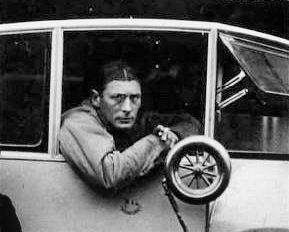Macrobertson Race - 1934
- Click on aviator's name for full biography
-
McGregor, Malcolm Charles
Malcolm Charles ‘Mad Mac’ McGregor, DFC and Bar 
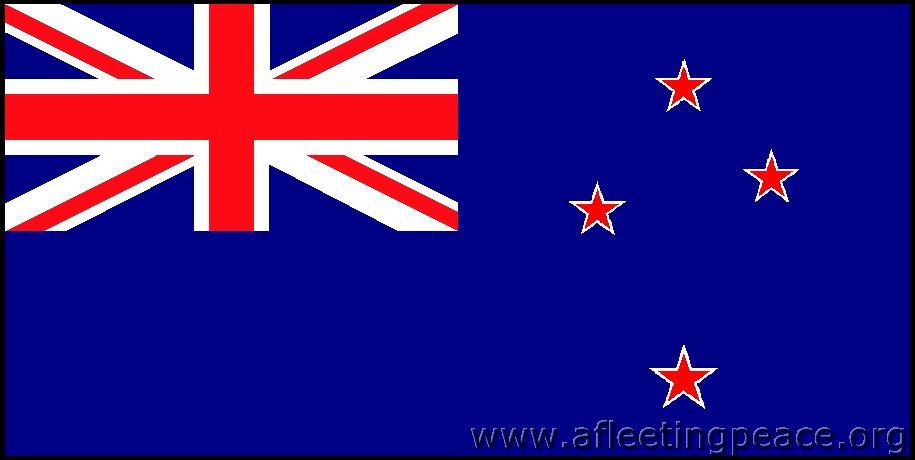 Born 4th March, 1896, in Manga-mako, near Hunterville, New Zealand; youngest of 3 children. 6ft 3in tall,' lean, with a prominent jaw and pale blue eyes'.
Born 4th March, 1896, in Manga-mako, near Hunterville, New Zealand; youngest of 3 children. 6ft 3in tall,' lean, with a prominent jaw and pale blue eyes'.54 Squadron during WWI, flying Sopwith Pups. Forced landing on June 29th, 1917 when he 'suffered a fractured jaw, loss of his teeth, and severe lacerations to his face and head'. Returned to France in May 1918 with Bishop's 85 Squadron, flying SE5s, ending the War with 15 victories.
Returned to farming, then worked with various start-up airlines in New Zealand, amassing thousands of flights. Crashed in 1923 and fractured his jaw. From 1932, instructor to the Manawatu Aero Club (crashed in December and - would you believe it - broke his jaw again, amongst other things).
After the Race, became Service Manager of Union Airways and toured the US (meeting up with Roscoe Turner) and the UK looking for suitable aeroplanes.
Killed in an accident (striking an anemometer mast) whilst landing a Miles Falcon at Rongotai, Wellington on the 19th February, 1936, aged 39.
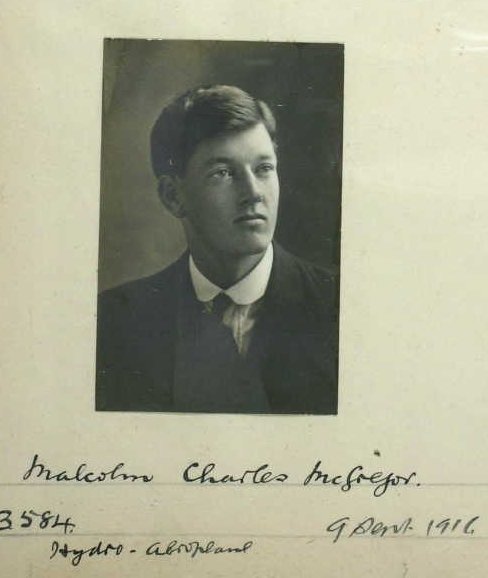
"Sqd. Ldr. Malcolm Charles McGregor, D.F.C. and bar, is a picturesque character frequently mentioned in War Birds. He commanded the Flight (in No. 85 Sqd.) in which both Elliott White Springs and the anonymous diarist served. The "Diary of an Unknown Aviator" is eloquent of exploits shared by " Bish and Mac," the former being Lt. Col. (then Major) W. A. Bishop, V.C. The laconic entry: "Bish and Mac got one each " becomes almost monotonous. But McGregor, who arrived in London (via Auckland, Sydney and Vancouver) on September 21, refuses to discuss these wartime encounters. Rapidly blinking a pair of bright blue eyes above a small brown moustache and pugnacious chin, he pleads lapse of memory : says he cannot even recall the name of the New Zealand town in which he was born ; but he knows the date—March 3, 1896.
Transferred from A.I.F. to R.F.C. early in 1916, and trained at Oxford, Netheravon and Upavon, McGregor served six months in France with No. 54 Sqd. (Sopwith Pups) before joining the redoubtable No. 85 (S.E.5A) on its formation at Hounslow uuder Major Bishop. He remained with the latter until demobbed in 1919. He then returned to New Zealand.
A member of the N.Z.A.F. since its formation in 1921, McGregor has also engaged in various civil activities. He was a partner in the now-delunct joyriding venture, Hamilton Airways. With a DH50 borrowed from the N.Z. Government, he operated a passenger service between Dunedin and Christchurch. With a Spartan he made a series of First Official Mail Flights throughout the Dominion. These and many other enterprises ended in 1932 with his appointment as chief instructor to the Manawatu Aero Club. He has flown 3,300 hr.
Major McGregor arrived in 1his country on the s.s. Aorangi on September 19, and was subsequently supplied with his machine at Reading.
A Loss to New Zealand
Flight regrets to record that Sqn.- Leader M. C. McGregor, the oldest competitor in the MacRobertson England- Australia race, in which he did so well, has died from injuries received in an air crash at Wellington airport. Frequently mentioned in War Birds (he commanded a flight of No. 85 Squadron), Squadron- Leader McGregor has been closely associated with civil and commercial flying in New Zealand in post-war years.
FEBRUARY 27, 1936
A "Falcon" for New Zealand
SQN. LDR. McGREGOR, who, since flying so well in the England-Australia race, has become a director of Union Airways of New Zealand, has recently placed an order for a Miles "Falcon" (" Gipsy " VI engine). This machine, which te identical with that entered by Viscountess Wakefield in the King's Cup, is* for use by the company. Incidentally, Standard Telephones and Cables are to install their ATR 4 radio sets in the- three D.H. 86s, ordered by this company and in the two D.H. 89s ordered by Cook Strait Airways, its associate. These five machines are to be delivered in October and the Palmerston-Dunedin and the Wellington- Blenheim-Nelson services should be in full swing before the end of the year.
AUGUST 29, 1935.
Malcolm Charles (Mac) McGregor, who was to achieve fame as a First World War air ace and later helped to establish civil aviation in New Zealand, was born on 4 March 1896 at Mangamako, near Hunterville. He was the youngest of three children of sheepfarmer Ewen McGregor and his wife, Matilda Chubbin. Little is known of his early life and education. Refused parental permission to enlist in the army during the First World War, he was allowed to train as a pilot instead. In March 1916 he entered Leo and Vivian Walsh's New Zealand Flying School at Mission Bay, Auckland, qualifying on 9 September.
In October 1916 McGregor sailed for England aboard the Willochra. After three months of advanced training with the Royal Flying Corps, he was posted as a fighter pilot to No 54 Squadron in France. On 29 June 1917, however, his operational flying was interrupted by injuries sustained in an emergency crash landing. After recovering in England, he served as a flying instructor. He found these duties frustrating, however, and in March 1918 he was reprimanded for allegedly performing stunts.
He returned to France in May that year, now with No 85 Squadron of the recently established Royal Air Force. Flying SE5a fighters throughout the final offensives of the war, McGregor was promoted to captain in June, and given command of his own flight. A recommendation for the Distinguished Flying Cross in August 1918 described him as 'a pilot of exceptional, even extraordinary skill' and 'a clever leader, full of resource and dash'. He was awarded the DFC and bar, and was credited with downing 10 enemy aircraft and an observation balloon. McGregor featured prominently in the celebrated American memoir War birds (1926).
The war over, McGregor returned to New Zealand in August 1919 aboard the Bremen. He worked initially on his parents' Waikato property, before purchasing a dairy farm at Taupiri. It proved difficult to sustain in the harsh economic conditions of the early 1920s, however, and he reluctantly disposed of it in 1925. He then managed his father's new farm at Rukuhia, near Hamilton. While there, McGregor married Isabel Dora Postgate, a law clerk, on 29 July 1925 at Frankton Junction; they were to have two sons and two daughters. The farm was sold in 1927 and he worked as a drover for the next two years.
Flying, however, remained McGregor's passion. He was a founding member of the New Zealand Air Force (Territorial) in 1923 and regularly attended its refresher courses over the following years. In September 1930 he was promoted to squadron leader and appointed commanding officer of No 2 (Bomber) Squadron. He was granted a commercial pilot's licence in April 1929, and formed Hamilton Airways with one de Havilland Gipsy Moth, which toured the country the following year; two other Moths were acquired later. Many New Zealanders gained their first experience of flying through a joyride with the company.
During the difficult years of the depression McGregor was involved in several false starts in the commercial sphere. In 1930 alone he was technical director of the short-lived National Airways (NZ), operated the 'Chocolate Plane' (a brown-painted Gipsy Moth) for Cadbury Fry Hudson Limited and, in partnership with F. Maurice Clarke, formed Air Travel. This company briefly operated a regular Christchurch--Dunedin service, but its survival, until mid 1932, was achieved chiefly through a combination of joyriding, carrying aloft well-known parachutists (such as Haakon Qviller and 'Scotty' Fraser) and undertaking experimental airmail flights.
In late 1932 McGregor secured regular employment as chief flying instructor to the Manawatu Aero Club. This was interrupted, however, by lengthy hospitalisation following a flying accident in December that year; he crashed during a competition in which pilots had to burst hydrogen balloons with their propellers. After his recovery he participated in the 1934 London--Melbourne centenary air race. With navigator H. C. Walker, McGregor flew a standard, single-engined Miles Hawk Major, named Manawatu , into a creditable fifth place and in the process broke two light-plane records.
Shortly afterwards McGregor became service manager with the newly formed Union Airways of New Zealand. He travelled to the United States and Britain in 1935 to investigate airline operations and equipment, and recommended that the company order de Havilland DH86 airliners. Union Airways commenced services from its Palmerston North base in January 1936, but McGregor was destined to enjoy little of its subsequent success.
On the afternoon of 19 February that year, while approaching Wellington's Rongotai aerodrome in wretched weather conditions, McGregor's Miles Falcon Major monoplane collided with the anemometer mast and crashed. He died of his injuries at Wellington Hospital two hours later. His sole passenger, C. W. F. (Bill) Hamilton (who later achieved international recognition for developing the jet boat), survived with minor abrasions.
Six feet three inches tall, of lean build, with fair hair and blue eyes, Mac McGregor was perhaps the best-known display pilot of his time; he also possessed an exceptional technical knowledge of aviation. His popularity was demonstrated by the extraordinary response to a national appeal launched immediately after his death, which raised over £5,000 to support his widow and their four young children.
MacRobertson—the Last Chapter
The news of the " better late than never " arrival at Darwin recently of R. Parer and G. Hemsworth in their Fairey " Fox," t i t e r various mechanical and other troubles, closes the last chapter of the Melbourne Race. Parer and Hemsworth are going on to Melbourne, and, it is said, the " Fox " will then be flown to New Guinea, for use by a mining company. A short time ago Philips and Powis (Aircraft), Ltd., of Reading, received a most entertaining account of the adventures of Sqn. Ldr. M. C. McGregor and H. C. ("Johnnie") Walker, who, with their Miles " Hawk Major," gained fifth place in the handicap, with an average speed of 105 m.p.n. Here are some extracts from their letter:—
"At the various aerodromes at which we arrived in daylight, we used to do what we later termed the ' Roscoe Turner stunt.' That was to put the nose down some distance away, and, quietly gathering speed, to end up over the aerodrome with the Pitot showing fifty the second time round. One of the officials at Allahabad said: 'Good heavens! What the h— is this you've got ? We thought the Comet was fast, but—!'
" I t was dark, again at Rangoon, and we found wireless mast? in the air everywhere at 2,000 feet, but no aerodrome After dodging these lights, and tearing around the skv for well over half an hour, both firmly of the opinion that we had done too much flying, we came in low down very cautiously from another direction. Some bright lad fired a very pistol, and we landed to find that we had struck one night in the year when the natives have a ' carnival of lights.' ' ie wireless masts were lanterns tied to balloons, and not Ruguv on a bigger scale !
" The trip to Alor Star was quite peaceful above the clouds, with us both trying to forget that machines with spats we warned not to land there. After re-fuelling, we managed with the help of numerous people to taxi to the end of the be They pointed out the best runway. It wasn't, and we end up in a mudhole at forty miles an hour. A number of the pulled us out, bent the spats straight, and this time, a taking the full 800 yards, we scrambled over a mudbank at the other end."
New Zealand's Air Services
IN the course of the past few months Flight has recorded piecemeal many ol the commercial aviation developments in .New Zealand. However, since service licences have now Ijeen issued it would be as well to detail the position as it appeared at the end of May. A few months ago Cook Strait Airways, Ltd., was registered with a capital of £50,000. A daily service was proposed connecting Nelson, Blenheim and Wellington—-a total distance of approximately 140 rnil«s. Capt, Bolt, the chk'i pilot of the company, is at present on a visit to America and this country, and is making an investigation of the types of machines likely to be suitable for the service. Union Airways of N.Z., Ltd., in which the Union Steamship Company is largely interested, was registered on May 1 with a nominal capital of ;£ 100,000, and is to start an air service between Palmerston North and Dunedin, in the southern portion of the South Island. The: distance from ix>int to point is a little less than 500 miles, and both Blenheim and Christchurch will also be served. Mr. N. S. Falla. the managing director of the U.S.S. Company and chairman of Union Airways, has also visiied England to purchase new machines which are to be entirely of British manufacture. Sqn. Ldr. M. C. McGregor has been appointed service manager •nd has already been to England. -.'
The projected and actual services in New Zealand.
Another company. Great Pacific Airways (N.Z.), Ltd., has 1M«II granted a licence to run a trunk service from Auckland to Dunedin, via New Plymouth, Wanganui, Palmerston North, Wellington. Blenheim, Christchurch and Tim.iru. The wdl at Wellington will be conditional on the provision of an emergency landing ground. Among the provisional directorate is Sir Charles Kingsiord Smith. Licences have also been granted to Air Travel (N.Z.), Ltd., for a West Coast service, and to East Coast Airways, Ltd.. for a ser%'iie linking Gisborne and Napier. The time is rapidly drawing near when New Zealand will need separate control and unified administration for civil aviation development. At present the Transport Co-ordination Board deals with applications for licences for air services, but it appears that this Board has no power to license machines, personnel or aerodromes. It can, in fact, only license air services, yet in spite of this the Board recently refused licences to certain concerns because they proposed using the Rongotai aerodrome at Wellington, although this is actually classed as suitable for all types of aeroplanes under
JULY 18, 1935.
'Flight'
-
Melrose, Charles James
Mr Charles James 'Jimmy' Melrose 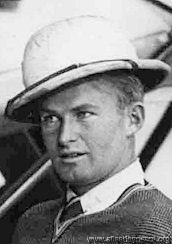
photo: 1934
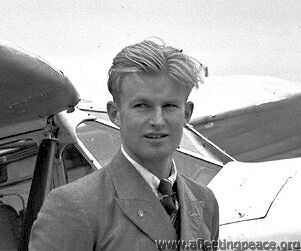
 Born 13th September 1913, in Burnside, Adelaide
Born 13th September 1913, in Burnside, Adelaide'Boy Phoenix', Australian pioneer. A 'big, well-set chap', who learned to fly with the South Australian Aero Club. With only 200 hours flying experience, he broke the Australia to England record in 1934.
[His uncle was Noel Pemberton Billing,
founder of Supermarine, well-known politician, inventor and, er, fruitcake, who leant to fly in one day in 1913].
Frankly, Jimmy sounds rather too good to be true; "a skilful and courageous natural flyer, Melrose was tall, flaxen haired and blue eyed; while conforming to the popular ideal of a hero, he avoided lionization. He exercised seriously, swimming at Glenelg where he and his mother lived; he kept early hours, neither smoked nor drank alcohol and ate 'Oslo' lunches."
No, I have no idea what an Oslo lunch is either, but I expect it's very healthy and nutritious.*
He flew to England to take part in the MacRobertson Race in 1934; before the race, which included a prize based on a handicap formula involving loads of parameters, Jimmy said the weight of his D.H. 80 Puss Moth would be fine ‘as long as I’m not in it’. Anyway, he did eventually win £1,000 by being placed 2nd in the handicap section.
Died 5 Jul 1936 near Melton, a farming town 25 miles north west of Melbourne, aged 22. His Heston Phoenix (the first of only 6 ever built), in which he offered rides 'from Adelaide to Anywhere', broke up in flight.
He had named the aeroplane 'Billing', his mother's maiden name; his first aeroplane was 'My Hildegarde' (his mother's name) and the second 'Westley' (her middle name). I think you could say he and his mother were 'close'.
Australia went into full celebrity funeral mode: "services were held simultaneously in Melbourne's and Adelaide's Anglican cathedrals; schoolchildren lined the route from St Paul's to Springvale necropolis, as planes circled overhead. In Adelaide both Houses of parliament suspended their sittings and St Peter's Cathedral was packed, mainly with women, who had idolized Jimmy. Three Royal Aero Club Moths flew over as the service ended."
Strewth!
*p.s. Helen Blake has kindly saved me the bother of looking up 'Oslo Lunch'; it's “a Norwegian invention combining a cheese and salad sandwich on whole meal bread, milk and fruit”. Thanks Helen, and in return I think we should all buy her book on Jimmy, 'Boy Phoenix' -
Moll, Jan Johannes
Jan Johannes Moll 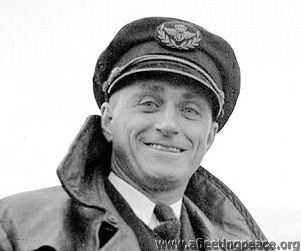
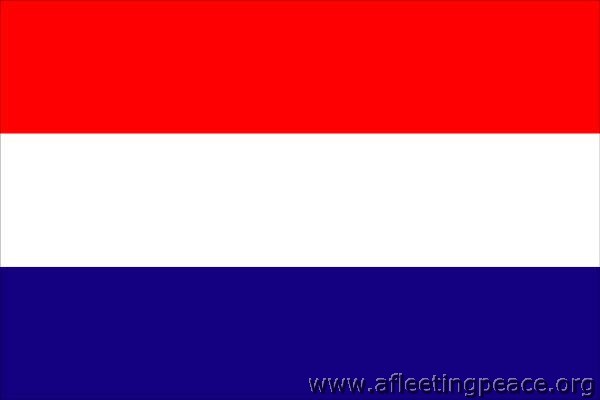
"Jan Johannes Moll was born at Surabaya on March 6, 1900, and entered K.L.M. by way of the Netherlands-Indian Air Force and K.N.I.L.M. In 1931, with Capt. Pattist (now K.L.M. Chief of Flying Services at Schiphol), Moll flew a Fokker FVIIB (Abel Tasman) from Batavia to Melbourne and back. His Indian Archipelago flying experience is probably unique."
Died at Aalsmere, The Netherlands, on 12th December 1988, aged 88
-
Mollison, James Allan
James Allan Mollison MBE 

with Amy and Sir Alan Cobham in 1932 or 33
 Born 19th April 1905 in Glasgow, and educated at Glasgow and Edinburgh Academies.
Born 19th April 1905 in Glasgow, and educated at Glasgow and Edinburgh Academies.RAF commission in 1923, transferred to reserve 1928, then a lifeguard and air-mail pilot in Australia. Made many record flights; his philosophy seems to have been "...one cannot be young for long, and it has always been my practice to live for the moment." He and Amy were married in July 1932, but They Said it wouldn't last, and it didn't; Jim had to fly Black Magic back by himself after the Race; Amy went on KLM.
Jim joined the Air Transport Authority (ATA) early in WWII, and carried on right through until 1946, ferrying more than 1,000 aircraft, comprising nearly every type used by the RAF - he was a 'Class V' pilot (authorised to fly any type of aircraft without previous instruction). He reckoned he had "on a conservative estimate, successfully delivered not less than 15 million pounds' worth of aircraft." - see https://www.ata-ferry-pilots.org/index.php/category-blog-1940/275-mollison-james-allanJim re-married and divorced twice, continued drinking [he once said that, when he was cold, tired and frightened, he recommended "brandy, lots of it"] and ended up as the owner of a hotel in Surbiton, bought for him by his third wife Mary [Kampuis], on the strict understanding that it would never be licensed to sell alcohol.
Died 30th October 1959 in Surbiton, London, aged 54, from alcoholic epilepsy.
 RAeC 1939
RAeC 1939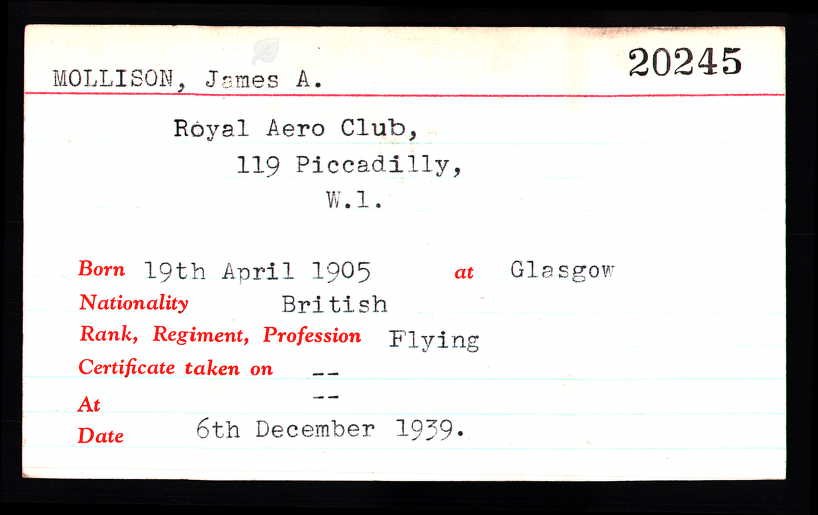 Educated: Glasgow and Edinburgh AcademiesCommissioned RAF 1923, transferred to reserve 1928, subsequently air-mail pilot in AustraliaRecord flights:Australia-England. July/Aug 1931. 8 days 19hrs 28minEngland-Cape (first flight by West coast Route) Mar 1932 - 4 days 17hrs 5minFirst solo Westward North Atlantic flight. August 1932First solo westward south Atlantic flight, and first flight England-South America, February 1933First flight England to USA (with Amy Johnson) July 1933England to India (with Amy Johnson) October 1934. 22 hoursNew York-Newfoundland-London (North Atlantic record crossing coast-to-coast 9 hours 20min) October 1936England-Cape by eastern route, November 1936. 3 days 6hrs.Joined ATA early in war. Released in 1946, after ferrying more than 1,000 aircraft, comprising nearly every type used by RAF - single, twin and multi-engined)Rank: Flight CaptainCategory as pilot: Class V (authorised to fly any type of aircraft without previous instruction)Ferried aircraft all parts of England, Scotland, North Ireland, France, Belgium, Holland.On conservative estimate successfully delivered not less than £15,000,000 of aircraft.For his war-time service in the ATA, Mr Mollison was awarded the M.B.E.
Educated: Glasgow and Edinburgh AcademiesCommissioned RAF 1923, transferred to reserve 1928, subsequently air-mail pilot in AustraliaRecord flights:Australia-England. July/Aug 1931. 8 days 19hrs 28minEngland-Cape (first flight by West coast Route) Mar 1932 - 4 days 17hrs 5minFirst solo Westward North Atlantic flight. August 1932First solo westward south Atlantic flight, and first flight England-South America, February 1933First flight England to USA (with Amy Johnson) July 1933England to India (with Amy Johnson) October 1934. 22 hoursNew York-Newfoundland-London (North Atlantic record crossing coast-to-coast 9 hours 20min) October 1936England-Cape by eastern route, November 1936. 3 days 6hrs.Joined ATA early in war. Released in 1946, after ferrying more than 1,000 aircraft, comprising nearly every type used by RAF - single, twin and multi-engined)Rank: Flight CaptainCategory as pilot: Class V (authorised to fly any type of aircraft without previous instruction)Ferried aircraft all parts of England, Scotland, North Ireland, France, Belgium, Holland.On conservative estimate successfully delivered not less than £15,000,000 of aircraft.For his war-time service in the ATA, Mr Mollison was awarded the M.B.E. -
Pangborn, Clyde Edward
Clyde Edward Pangborn 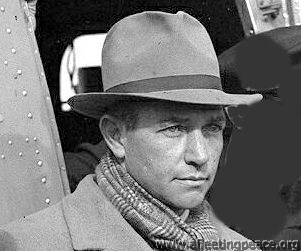
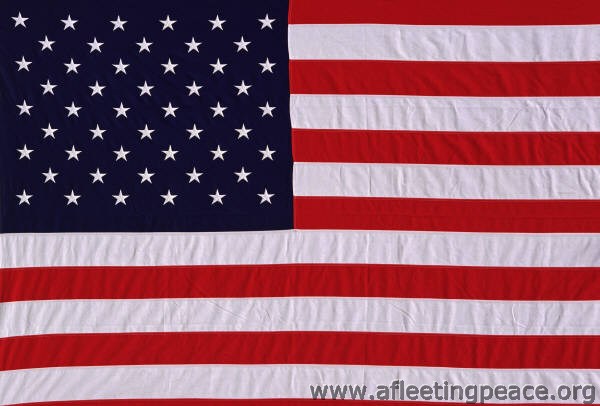
b. 28 Oct 1895
d. 29 Mar 1958, aged 62
-
Parer, Raymond John Paul
Raymond John Paul Parer
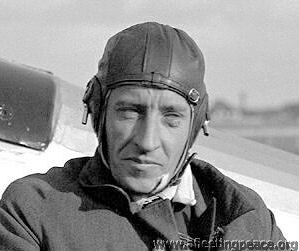
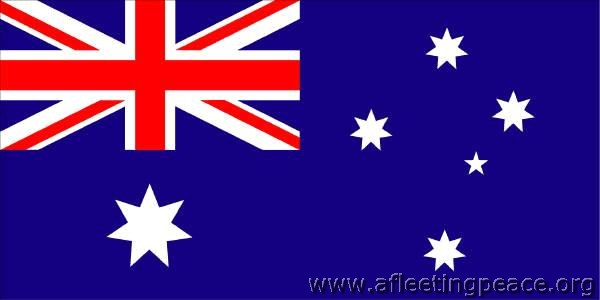 b. 18 February 1894, in Melbourne, the second of seven sons.
b. 18 February 1894, in Melbourne, the second of seven sons.Joined the RFC during WWI, but a medical officer had insisted that Ray's heart 'was not strong' and he wasn't allowed to fly above 10,000 ft.
The only person to compete in the Air Races from England to Australia in both 1919 and 1934.
For the 1919 Race, he and John Cowie Macintosh persuaded Scottish millionaire distiller Peter Dawson to give them the money for an aeroplane, but only dared ask enough for an F.E.2b (although they would have preferred a DH.9). When Mr Dawson heard this, he scolded them and gave them another cheque. Battling their way through delays, innumerable forced landings and hair-raising exploits, they finally arrived nearly 8 months later, skint and with empty fuel tanks, only the second crew ever to make the journey.
In 1927, when the New Guinea Gold Rush began, he shipped a DH.4 there and set up the Bulolo Goldfields Aeroplane Service.
Tried to enlist in the RAAF in 1941, but was deemed too old and joined the Merchant Navy instead.
He was 'by nature shy and retiring' but clearly, never gave up - hence his nickname 'Battling'.
Spent the last 20 years of his life farming near Brisbane, and died there 5th July 1967, aged 73.
-
Parmentier, Koene Dirk
Koene Dirk Parmentier 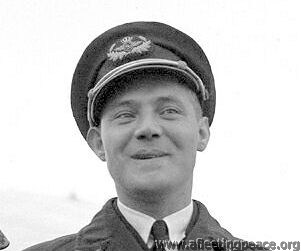
 b. 26 September 1904 in Amsterdam
b. 26 September 1904 in AmsterdamTrained in the Dutch Air Force, and one of the first Dutch pilots to qualify for a navigator's licence, he joined K.L.M. in 1929 and flew on its mail routes, chiefly as commander of Amsterdam-Batavia liners.
In 1933 he spent four months in America, nightflying over various routes and studying their operation.
d. 20 Oct 1948, aged 44, when the K.L.M. Constellation airliner he was piloting on a flight from Amsterdam to New York crashed and burst into flames on a farm near Tarbolton, Ayrshire near Prestwick Airport.
-
Polando, John L
John L Polando 
 b. 6 September 1901
b. 6 September 1901d. 13 August 1985, aged 83
-
Scott, Charles William Anderson
Mr Charles William Anderson Scott 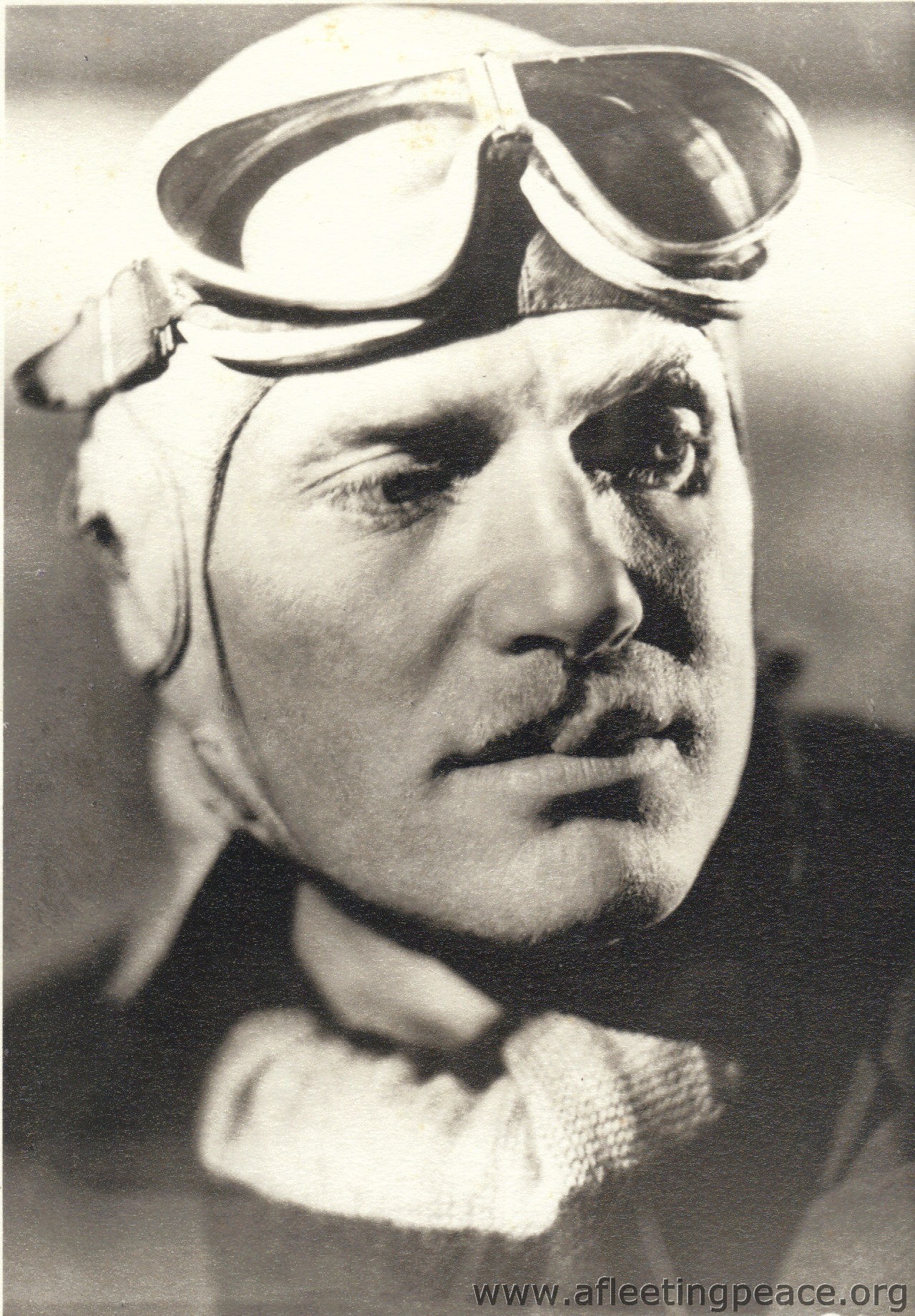
photo: 1934, aged 31
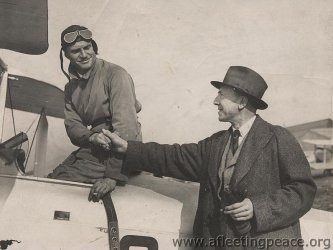 with his father Charles
with his father CharlesBorn 13thFebruary 1903 in London
One of the truly great aviators of the 1930s, establishing many long-distance records and winning some of the most important long-distance races of the period, but rather went to seed after that and shot himself after WWII. Scott wrote a book, and enterprisingly called it 'Scott's Book'.
"Scott is a splendidly-built six-footer, always in excellent condition. His other sporting recreations are golf and sailing."
"Charles Wiliam Anderson Scott, aviation editor of the 'News Chronicle', is the elder son of Mr Charles Kennedy Scott, the musician and conductor.
Educated at Westminster School, the future airman began his career as a sugar planter in Demerara, South America. The experience did not prove at all to his liking and he returned to England in 1922. Sailing was his passionate hobby - it still is - but as a youth trying to find his rightful career, flying did not occur to him until a friend suggested joining the Royal Air Force. Young Charles Scott sent in his application and thought little more about it until he found himself accepted and ordered to report to the Flying School at Duxford.
The Royal Air Force occupied the next four years of his life [he was heavyweight and light-heavyweight boxing champion whilst in the RAF] and in 1926 he was again wondering what was the next move when chance played the deciding game again. A sharp shower of rain sent him scurrying into Australia House for shelter with the result that he was bound for Australia not many weeks later.
There Scott became a pilot with Qantas Ltd., flying the mail routes in Western Queensland and acting as a flying instructor from 1927 to 1930. During that period he met the late Bert Hinkler, Mrs Mollison and the late Sir Charles Kingsford Smith and was inspired to break records.
Scott resigned his flying job in Queensland and came to England in 1931 determined to break the England-Australia record, despite accumulating financial troubles caused by the rising Australian rate of exchange.
He got there, reducing the record to 9 days 3 hours. That year he flew back again and made another record of 10 days 23 hours. Both flights beat Sir Charles Kingsford Smith's times.
In 1932 he attacked the England-Australia record for the second time and regained it with 8 days 20 hours.
The greatest adventure of his career was the magnificent flight in the Mildenhall-Melbourne air race of 1934 when he and the late Tom Campbell Black reached Melbourne in just under 3 days.

On September 17, Scott was married to Miss Greta Bremner, younger daughter of Mr and Mrs E L Bremner, of Melbourne, Victoria, Australia, only 12 days before the start of the Johannesburg air race."
- from the Celebration Dinner programme after the race (October 14th 1936 at Claridge's Hotel).
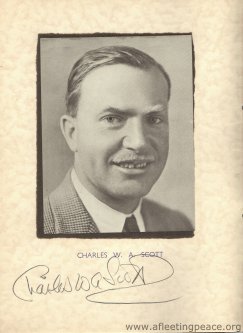
In 1936, his "Flying for All" Display embraced over 150 centres in the United Kingdom and Irish Free State, and was aimed particularly at "familiarising people with some of the cheap, easy-to-fly light aeroplanes available to-day".
Died 15th April 1946, in Germany, aged 43
.jpg)

p.s. The £10,000 MacRobertson first prize would, using average earnings, be worth about £2 million today.
-
Shaw, Geoffrey
Wing-Cmdr (AAF) Geoffrey Shaw DFC 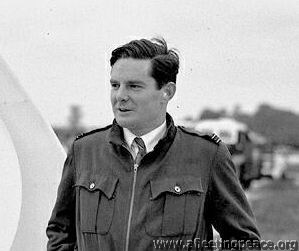 1934, before the MacRobertson Race
1934, before the MacRobertson Race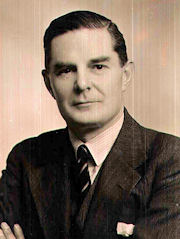 1947
1947[with family insights kindly provided by Louise Wilkinson, author of 'The Kipper Patrol', who interviewed Geoffrey's wife in October 2009]
Geoffrey was born in Saltburn by the Sea, Yorkshire, in 1902, the second of 5 boys whose mother died at the age of 32 when he was 7. His father, who owned the Wellington Cast Steel Foundry in nearby Middlesborough, was unable to cope with the five boys, so Geoffrey was sent to public school in Scotland.
He then studied engineering at Cambridge; whilst there, he met a friend who wanted to learn to fly, so the two of them went and found someone who could teach them both. After Cambridge, he went back to work in the family business, Wm Shaw & Co Ltd.
"He was a very good engineer. He never reckoned he was very smart at anything learning wise, I don’t think any one else did either, but he was very good at all kinds of sport.
"He found a small aerodrome where he could continue flying to build up his hours."
NEWCASTLE-UPON-TYNE AERO CLUB REPORT
for week ending June 5, 1927. —-Total flying time : 33 hrs. 10 mins.
Dual with Mr. Parkinson :—Mrs. Heslop, Miss Leathart, Dr. Watt, Messrs.Elmes, Thirlwell, Heaton, Jewett, Wilson, G. Shaw, Gibson, George, Macalpine Downie, Pargeter, Bainbridge, and Capt. Milburn.
Solo :—Capt. Milburn. Miss Leathart, Drs. Dixon and Watt, Messrs. Leech, R. N. Thompson, C. Thompson, Mathews, H. Ellis, Turnbull and W. B. Ellis.
Report for week ending June 12.
Dual with Mr. Parkinson :—Sir J. Reed, Craig, Elmes, Jewett, Thirlwell,Gibson. Heaton, Turnbull, Wilson, Phillips, H. Ellis, Davey, Miss Leathart, and Mrs. Heslop.
Solo :—Miss Leathart, Messrs. Turnbull. H. Ellis, R. X. Thomspson, C. Thompson, Leech, W. B. Ellis, Phillips, Dixon, Todd and Mathews.
Report for week ending June 19.—Total flying time : 23 hrs. 20 mins.
Dual with Mr. Parkinson :—Mrs. Heslop, Messrs. Rasmussen, Elmes, Jewett, Heaton, Turnbull, Wilson, Irving, W. Todd, Davey, Maxwell, Pargeter,and Flying-Officer Dawson.
Solo :—Flying-Officer Dawson. Dr. Dixon, H. Ellis, Turnbull, C. Thomson, R. N. Thompson, Mathews, W. B. Ellis.
On Tuesday, Mr. Parkinson flew to Edinburgh, returning with Sir Sefton Brancker. After tea. Sir Sefton Brancker continued his journey to Sherburn in a Yorkshire Club Moth piloted by Mr. Fielden. Friday saw LX off service, and gales prevented any flying on Saturday and Sunday.
The Secretary is still confined to his bed, but it is a pleasure to report that he is making slow but steady progress."
[Interesting to see that his contemporaries in Newcastle included Connie Leathart;
Geoffrey finally got his aviator's certificate, No 9,240, on the 21 June 1930, at the Newcastle Aero Club.
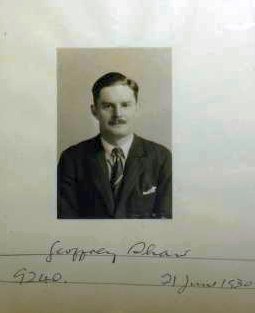
"When the Auxiliary Air Force was created, he was very keen to join so he went straight to 608 Squadron at Thornaby Aerodrome."
[No. 608 Squadron was formed at Thornaby-on-Tees, North Yorkshire as No. 608 County of York (North Riding) Squadron, on 17 March 1930.]
Geoffrey then transferred to the Yorkshire Aero Club, at Yeadon:
July 8, 1932
"Six members joined the Yorkshire Aeroplane Club during June, amongst them being Mr. Geoffrey Shaw and Mr. A. C. Thornton. The latter is the designer of the 'Arrow Active', and his latest production, the 'Active II', has been much in evidence, being tested by F/O.H. H. Leech."
"He bought a small aeroplane for £60, it was absolutely gorgeous... I learned to fly in it too. It had an open cockpit, which is the nicest place to learn to fly. Just 4 cylinders, it was as light as a feather... he always let me fly it. If we got somewhere where we didn’t know he would say to me, wake me up before we land, I think he always thought he should be awake in case I mucked it."
 Avro Avian
Avro AvianThe first aircraft registered to Geoffrey was a 1927-model Avro 594 Avian III, G-EBVA (he is listed as the 6th owner), followed by Avro 616 Avian IVM, G-ABMO, first registered in May 1931 to Francis Montague (although he doesn't look very happy about it):
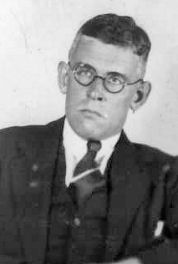
And then, completely out of the blue in 1934 (he admitted he had never flown further than 'near Paris' before), Geoffrey decided to enter the "World's Greatest Air Race" - the MacRobertson Race from England to Australia.
He bought a brand-new B.A. Eagle I, G-ACVU, in July 1934, and had a special inscription painted on it - "The Spirit of Wm Shaw and Co Ltd, Wellington Cast Steel Foundry, Middlesborough, ENGLAND"
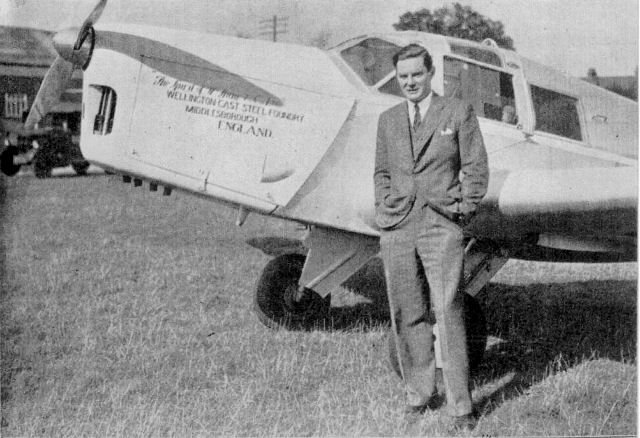 Geoffrey with the Eagle, via Louise Wilkinson
Geoffrey with the Eagle, via Louise WilkinsonHe was allocated Race No 47. He bought his maps in late August, but wasn't sure they were accurate enough - and, he asked the organising committee, "What height should I fly at?" They replied, "We have no idea - you'll have to ask the people who sold you the aeroplane".
ABC's Guide to the Macrobertson Race described him thus:
"G Shaw, a member of a wealthy Yorkshire family, recently resigned from the Royal Air Force. The fact that he was personal pilot to the late Sir Sefton Brancker, British Controller of Civil Aviation, is an indication of his flying calibre."
[The 'personal pilot to Sefton Brancker' stuff is probably nonsense - Brancker, together with Lord Thomson, the Air Minister, was killed in the disastrous wreck of the R101 airship near Beauvais, France early on 5 October 1930, during its maiden voyage to India. Geoffrey only got his aviator's certificate a few months before that.]
He got as far as Baghdad, though, before retiring with 'gear trouble', so got his £10 entrance fee back.
Geoffrey married Elizabeth in July 1935; here they are with the Eagle during a Hungarian Holiday in August.

He then sold the aeroplane, and it later crashed into the sea off Corsica, on 13 Apr 1936.
Geoffrey continued with 608 Sqn, eventually taking over from Geoffrey Ambler:
The Times Nov 11 1938: "Royal Air Force Squadron Leader G. H. Ambler has relinquished the command of No. 608 (North Riding) (Fighter) Squadron of the Auxiliary Air Force, which he had held since December, 1934. He had served with the squadron since February 1931, a few months after it was established.
His successor is Flight Lieutenant Geoffrey Shaw, who is granted the acting rank of squadron leader from October 30. He has been with the squadron since August, 1930, and has held the rank of flight lieutenant since 1933. No. 608 was originally a bomber squadron, and was converted for fighter duties in January 1937, when it exchanged its Wapiti bombers for Demon fighters."
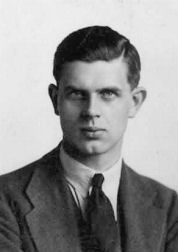 Geoffrey Hill Ambler (q.v.)
Geoffrey Hill Ambler (q.v.)Geoffrey bought himself another aeroplane; G-ADVH, a GAL Monospar Jubliee, from Albert Batchelor of Ramsgate. This aeroplane was impressed in March 1940 as X9365, but crashed at Saighton Camp 3 weeks later.
When WWII broke out, Geoffrey continued with 608 Sqn and was promoted to Wing Commander:
"By September 19th 1939, the squadron was available for anti-submarine patrol from 0600 hours to 1600 hours with four Ansons on standby, but the first operational flight of 608 Squadron was not made until the 21st. of September 1939, when an Anson serial number N5207, was flown by Squadron Leader G. Shaw, Flying Officer Woolcock and crewed by L.A.C. Kelly and Corporal Knott, who took off on an anti-submarine patrol in response to a false alarm.
Over Christmas and the New Year of 1940, everyone suffered freezing conditions and constant outbreaks of influenza"
THE KIPPER PATROL
Remembered by some veterans as “the kipper patrol”, their job, as part of Coastal Command, involved protecting shipping convoys, looking for submarines and defending the northern supply routes. Although their role was never seen as glamorous and never received national glory, nonetheless, they played a significant part in the defence of the United Kingdom. This book tells the story of young pilots such as Geoffrey Ambler, Geoffrey Shaw, William Appleby-Brown and Peter Vaux, and airmen such as Albert Guy, Harold Coppick and Syd Buckle, and considers how their lives were dramatically changed with the onset of the Second World War, which saw them cease to be part-timers and become full time members of the Royal Air Force.
http://www.pneumasprings.co.uk/The%20Kipper%20Patrol.htm
He was Mentioned in Despatches in July 1940, and awarded the DFC on 6 March, 1941.
"I still don’t know what he got his DFC for in 1941. He never told me anything about his work."
He continued flying after WWII; here is his post-war aviator's certificate:


Geoffrey died, after a long illness, in 1977 in Malta, aged 75. He is buried there.
"There are no photos of him left as he burnt them all one afternoon after the war ended."
-
Smith, Wesley Leland
Wesley Leland Smith 
 b. 9 January 1894
b. 9 January 1894 -
Stack, Thomas Neville
Capt Thomas Neville Stack 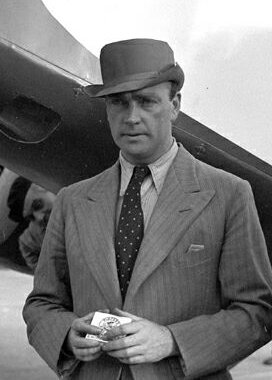 1934, aged 38
1934, aged 38
RAeC [0312-0087]
b. 1 April 1896; universally known as 'Stacko'
RFC in WWI, then became a familiar figure in aviation circles during the 1920s - in 1926 he and Bernard Leete made the first flight from England to India in two DH. Moths, one of several record-breaking flights.
He and J R Chaplin tried to fly to Australia and back in 1931, but had to turn back at Constantinople, Turkey, with carburettor trouble; later in the year the same pair attempted a flight to India and back, but again turned back with mechanical problems.
He was appointed 'Air Superintendent' of Iraq Airwork Ltd in 1933, and flew their first machine (a Spartan Cruiser) there via Cairo in 1933. Shortly afterwards, he flew 2 doctors and a nurse out to India, to perform an urgent operation on a Nepalese princess.
Late 1933 found him testing the Airspeed Courier - which is probably where he met Sydney Turner - and was widely expected to fly it in the MacRobertson Race. A month before the race, he broke (his own) London-Copenhagen record in a Miles Hawk, which is perhaps why he was too busy to inspect the Viceroy properly....
He turned up for the MacRobertson Race looking very tired and drawn - Alan Goodfellow described him as looking 'over-trained, physically', and Neville Shute Norway said he was "an exhausted and a worried man".
Shortly after the race, he was appointed Air Superintendent and Manager of Hillman's Airways; after that became part of British Airways he spent time in Turkey, advising them on civil aviation.
He was killed when run over by a lorry in Karachi, India on 22nd February 1949, aged 52. At first, the Karachi Police said he had committed suicide but, while agreeing that he was 'on the verge of a nervous breakdown', the inquiry decided that the cause of death was actually an aneurism of the aorta, and he would have died anyway.
Neville was "always very good company. He was never happier than when singing a song and strumming on his banjo."
-
Stodart, David Edmund
Sqn-Ldr David Edmund Stodart DSO  1934
1934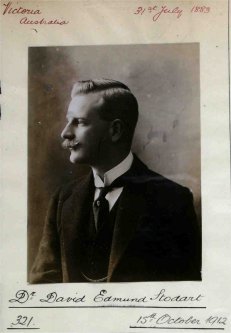 1912
1912 Born 31st July 1882, in Gobur, Victoria, Australia, eldest of seven children.
Born 31st July 1882, in Gobur, Victoria, Australia, eldest of seven children.Went to Edinburgh to study medicine; a very early aviator (RAeC Certificate No 321, in 1912); pre-WWI racer in England as 'Dr Edmund'. Mentioned in dispatches three times during WWI, promoted eventually to Major, he was awarded the DFC and later the DSO.
Post-WWI, RAF Squadron Leader in the Middle East:
"Cobham to go on
Successor to Shot Airman Chosen
Airmen have been searching for two days to trace the Arab sniper who shot Mr. A. B. Elliot, the air mechanic, who was accompanying Mr. Alan Cobharn on his flight to Australia and back.
Accompanied by Squadron-Leader David E. Stodart, D.S.0., of the Shaibah Iraq Bombing Squadron, Mr. Cobham flew back to Nasiryah yesterday.
Mr. Cobham is to continue his flight. The Havilland Aircraft Company is sending Mr. Moore, of the Armstrong Siddeley firm, to take the place of Mr. Elliot" - Daily Herald - Friday 09 July 1926
...then back to Middlesex Hospital as a physician in the dermatology department.
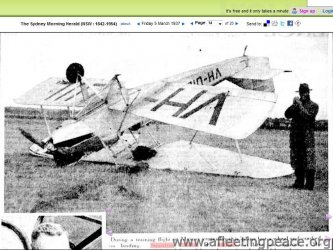
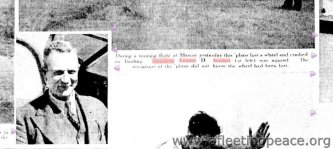
![MacRobertson Race 1934 K4047 Airspeed Courier (David Stodart) [0822-0032]](/images/gallery/air%20races/MacRobertson/preview/333s333/MacRobertson%20Race%201934%20K4047%20Airspeed%20Courier%20%28David%20Stodart%29%20%5B0822-0032%5D.jpg)
Oldest and 'most casual' competitor in the MacRobertson Race, but the first Australian to reach Melbourne. He and Kenneth should have won one of the handicap prizes - possibly even the First Prize - but mistakes in the handicapping system robbed them of the glory they deserved, not to mention the cash.
After the Race, he stayed on in Australia for a while, mostly working as a flying instructor, then finally came back to England, where he died 26th February 1938 in Brighton, aged 55:
"LONDON. February 28
The death has occurred of Squadron-Leader David Edmund Stodart, who, owing to the Incapacitatlon of all the officers in his detachment in war time, did the work of an entire squadron for three weeks, Including the administration of bombing. observing and photographing.Stodart. when 52, was sixth In the Melbourne air race In 1934."p.s. the £2,000 for the Handicap Race prize would be worth about £400,000 today...might have been useful, considering that David's estate when he died was £157.
-
Stodart, Kenneth Gerald
Kenneth Gerald Stodart 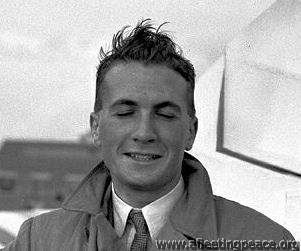
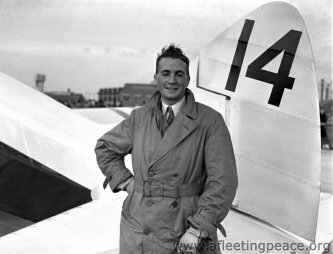
b. 1910
David Stodart (q.v.) said that 'Our grandfathers were first cousins, work it out for yourself, it’s too much for me”.
A Sergeant Pilot in the RAF, later to test-fly the 'Luton Buzzard' light aircraft.
d. 15 Sep 1938 in Princess Mary’s Royal Air Force Hospital, Halton, Buckinghamshire, after a flying accident, aged 28
-
Turner, Roscoe
Roscoe Turner 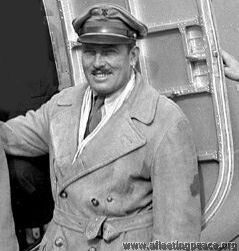
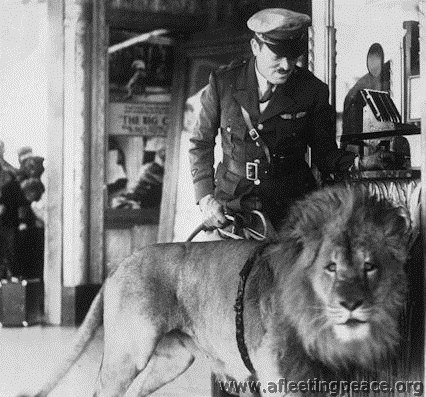
and Gilmore the Lion
 Born 29th September, 1895 in a small farmhouse near Corinth, Mississippi; left school at 16, became a car mechanic, then a 'balloon pilot' in France and Germany during and after WWI.
Born 29th September, 1895 in a small farmhouse near Corinth, Mississippi; left school at 16, became a car mechanic, then a 'balloon pilot' in France and Germany during and after WWI.Always called himself 'Colonel' (although he only reached First Lieutenant in the Army), wore a (self-designed) uniform - cap, sky blue tunic, jodhpurs and boots - and, although he said that he didn't particularly like wearing 'this monkey suit', he reckoned that it 'makes people notice me'.
As, perhaps, did Gilmore the lion cub, who flew with him (to begin with, on his lap) and had his own parachute. (Later known as Gilmore the Lion, and finally...

Gilmore the Stuffed Lion).
Dare-devil barnstormer, wing-walker and parachutist through the 20s; permanently penniless, he was sentenced to a year in jail in 1922 when he unknowingly bought a stolen plane (he was later pardoned). Moved to Los Angeles and flew for the movies, including Howard Hughes' 'Hells Angels', but it was from a combination of flying movie stars on charter trips and air racing that he finally made some money.
"There was only about a dozen people in the United States in 1939 who had flown over 300 miles per hour - after 1926, just a handful of us kept speed development going".
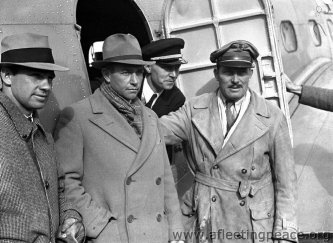 with Clyde Pangborn before the 1934 MacRobertson Race
with Clyde Pangborn before the 1934 MacRobertson RaceA hugely successful air racer - winner of the Bendix Trophy, and the Thompson Trophy 3 times.
Died 23rd June, 1970 in Corinth, Mississippi, aged 74 (Gilmore died in 1952, aged 22).
Roscoe is buried in Crown Hill Cemetery, Indianapolis, Marion County, Indiana.
Gilmore is in the Smithsonian!
-
Turner, Sydney Lewis
Sydney Lewis Turner 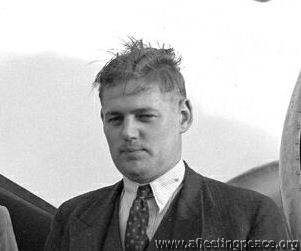
![MacRobertson Race 1934 Sydney Turner [0823-0004]](/images/gallery/air%20races/MacRobertson/preview/333s333/MacRobertson%20Race%201934%20Sydney%20Turner%20%5B0823-0004%5D.jpg)
(c) RAeC [0823-0004]
b. 25 May 1912, in Eltham, London
Got his Aviator's Certificate in August 1933 with Surrey Flying Services, then became Director of Aircraft Exchange and Mart (Sales agents for Airspeed) in 1934.
He always wrote in either green or turquoise ink, his spelling was terrible, and he had to remind the organising committee for the Race that the aeroplane had been "entered jointly by Stack and myself", so would be grateful if they would copy him in on any correspondence.
He and Stack teamed up for the MacRobertson Race as "Turner had the money but Stack had the reputation". [Stack admitted that he had been "having a bad time financially"].
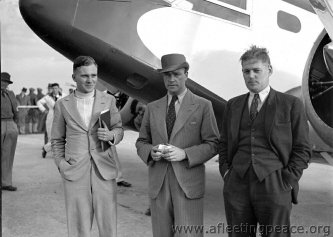 MacArthur, Stack and Turner befoe the race
MacArthur, Stack and Turner befoe the raceAfter their early withdrawal from the Race, Stack and Turner sued Airspeed. They contended that the aeroplane - the specially-built Airspeed Viceroy - wasn't really ready; it vibrated alarmingly, the brakes locked up, the electrics were positively dangerous, and the fuel consumption was double what they had been promised. Neville Shute Norway of Airspeed described these as 'trivial defects'.
Stack and Turner finally withdrew the accusations and had to hand back the aeroplane - for which they'd paid £2,448 as a first instalment - and another £1,850 cash. The aeroplane stood around for a while then, just as it was being prepared by Max Findlay and Ken Waller to fly in the Schlesinger Race in 1936, representatives of the Spanish Republican Air Force made them an offer they couldn't refuse: Findlay and Waller had to make do with an Envoy. Which crashed, killing Max and the radio operator.
In 1935 Sydney entered his Percival Gull for the King's Cup Air Race, but didn't, in the end, take part.
In 1944 he was a test pilot for Rolls Royce in Nottingham.
-
Walker, Henry Campbell
Henry Campbell ‘Johnnie’ Walker 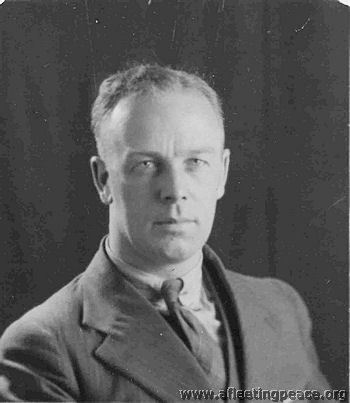
Walker and Macgregor
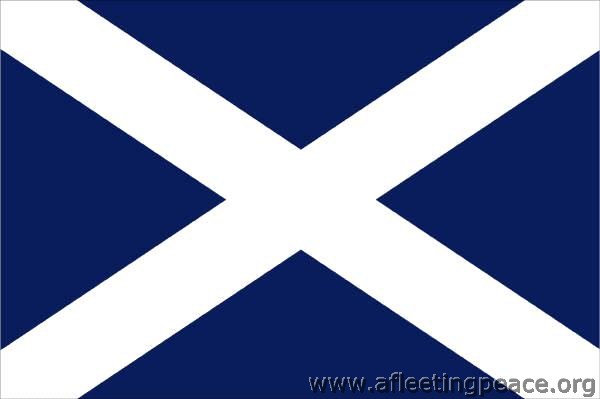 b. 15th March, 1908, in Edinburgh, but moved to New Zealand when 8 years old, so
b. 15th March, 1908, in Edinburgh, but moved to New Zealand when 8 years old, so  really.
really.Got his aviator's certificate in 1930 but had only flown about 250 hours, none of it outside NZ, at the time of the MacRobertson Race.
Joined Union Airways, then Squadron Leader in the RNZAF during WWII; awarded Air Force Cross in January 1943.
Post-war with New Zealand Airways - did the delivery flight of their first Viscount in 1957, and was still around when it was replaced by the Boeing 737.
d. c. 11th Nov 1991, in Wellington, N.Z., aged 83
-
Waller, Kenneth Herbert Fraser
Mr Kenneth Herbert Fraser 'Ken' Waller 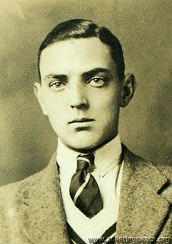 1930, aged 22
1930, aged 22
b. 7 April 1908, in Lambeth, London
As you can see, he was over 6ft 4in in height. Despite this, learnt to fly in Kent, got his aviator's certificate in 1930 and then became an instructor at Brooklands in Surrey.
Pilot, with Owen Cathcart Jones, of one of the D.H. Comets for the MacRobertson Race in 1934; given third prize (erroneously, in my view, but it's probably a bit late to say that now).
In 1935, got annoyed with Owen Cathcart Jones for something he said in his book that Ken felt "reflected on his courage and ability as a pilot", and even went to court over it. Owen replied that "that was the last thing he intended, as Mr. Waller and he had been, and still were, very good friends", which seemed to settle the matter.
He and Max Findlay competed in the Schlesinger Race to South Africa in 1936, in an Airspeed Envoy (No 13), but this crashed on take-off in Northern Rhodesia, killing Findlay and the radio operator; Ken was thrown out through a hole in the fuselage and badly hurt.
After WWII, became Miles Aircraft's chief test pilot (he delivered a Hillman Minx car to Orkney in 1948 at a cost of £35, you may remember).
-
Woods, James
James 'Jimmie' Woods 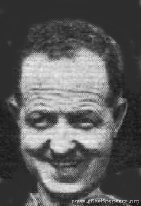

 b. 13 Nov 1893 in Udny, Aberdeenshire, Scotland
b. 13 Nov 1893 in Udny, Aberdeenshire, Scotland"JIMMIE WOODS is reluctant to talk about himself, and cannot believe that anyone is interested in such personal matters as his age and birthplace. He was born "in Scotland about thirty-nine years ago," served with R.F.C. and R.A.F., and has flown some 11,000 hours."
He spent eleven years a pilot with West Australian Airways, Ltd., flying up and down the 2,035-mile coastal route from Perth to Wyndham, and across the 1,453-mile transcontinental route from Perth to Adelaide; in 1933 he flew a Gipsy Moth from Australia to England.
Woods spent some time at the Lockheed plant in Burbank, flew across America in a Boeing 247, (which he described as "a very clean job"), then flew to England and collected the late Lt.-Com. Glen Kidston's Vega at Hanworth.
Died 9th May, 1979, aged 85
-
Wright, John Henry
John Henry Wright 
 b. 8 November 1894 in Clark Mills, N.Y
b. 8 November 1894 in Clark Mills, N.Yd. 1 May 1979, aged 84
Page 2 of 2

